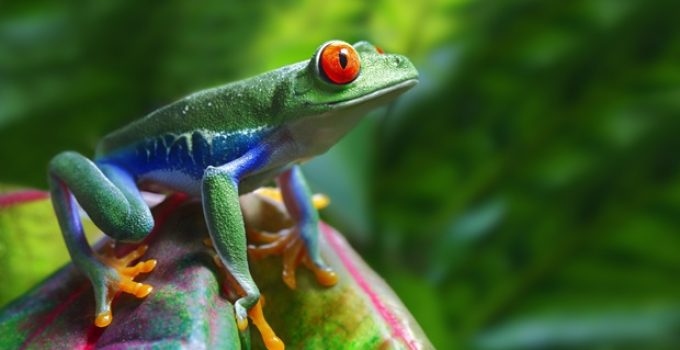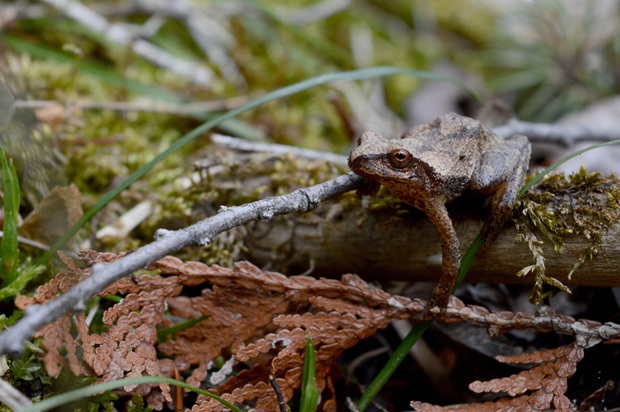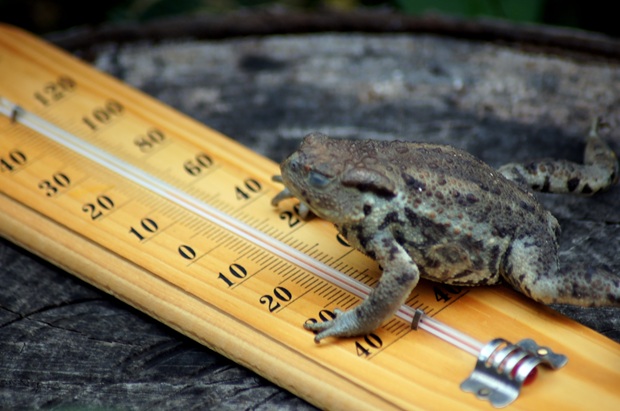Do Frogs Hibernate?
Answer at a Glance: Frogs do hibernate. Frog species employ one of two strategies to avoid severe temperatures: freeze avoidance or freeze tolerance. Freeze-avoidance species can tolerate low temperatures but will die if they freeze. Freeze-tolerance species undergo reversible extracellular freezing, a process where the frog’s body fluids freeze outside the cells, allowing the cells to remain unfrozen and intact.
Dig Deeper
- Hibernation Tactics: Freeze Avoidance
- Hibernation Tactics: Freeze Tolerance
- Physical Characteristics of a Hibernating Frog
- Resources
Hibernation Tactics: Freeze Avoidance
As an ectotherm, the frog cannot regulate its body temperature internally and, therefore, relies on external forces to do so. When the temperatures begin to fall, so does a frog’s body temperature. [1] The frog’s metabolic rate will start to slow in response to cold temperatures, and it must find a place to wait out the winter before it freezes. [2]
Aquatic Species
Many frog species choose to remain in the water during their hibernation period. They will lightly cover themselves with mud at the bottom of the pond to escape being seen by predators. [3]
But if a frog breathes through its lungs and can drown if too much water enters the lungs, how can it survive extended periods underwater? The state of torpor created by hibernation requires less oxygen intake, so they only need to replenish their oxygen reserves periodically. If they cannot get air, such as in instances where a pond has frozen over, they can breathe through a process called cutaneous respiration. Their skin is highly vascularized, allowing oxygen to diffuse easily when moist. The frogs only bury themselves enough to remain hidden but not sufficiently to cover their skin and block respiration, as the mud holds very little oxygen. [4]
They must also choose their hibernaculum carefully. For example, frogs that choose a stagnant pond or a swimming pool are at a higher risk of freezing or drowning than frogs that prefer fast-flowing water sources. This is because stagnant water carries less oxygen than flowing water, potentially becoming anoxic or hypoxic. Stagnant water will also freeze over more readily, leaving the frog with no way to obtain fresh oxygen. [5]
Terrestrial
As the name implies, terrestrial frogs will normally hibernate on land. Terrestrial frogs must find hibernaculum that will not freeze, such as hollowed tree roots or natural crevices that are far below the frost line. [6]
Hibernation Tactics: Freeze Tolerance
There are several species of freeze-resistant frogs, the most notable being the wood frog. How do these species differ in terms of hibernation? Rather than hiding from frost, freeze-resistant frogs can actually ‘freeze’ during the winter and thaw out in the warmer weather. [7]
Freeze-tolerant frog species do not need to hibernate far underground to avoid frost. They simply find a log, rock, or any leaf litter to hide beneath and allow the temperatures to transform their bodies. [8]
When temperatures drop and freezing begins, water is drawn from the cells of the frog’s vital organs into extracellular spaces such as between the skin and muscles. Here, the liquid can crystallize without damaging the organs. [9] As ice crystals form in the tissues, the liver produces high concentrations of glucose that help prevent damage to the cells and tissues. This extra glucose is distributed through the bloodstream to vital organs, such as the heart and brain tissue. Breathing, heartbeat, and most other crucial bodily functions will then cease. This entire process usually occurs in the first 24 hours after freezing begins. [10]
The freezing process must occur slowly while the body temperature is still high, allowing the water to leave the vital organs before freezing. If freezing occurs too quickly, the water in the organs will freeze and shut down, and the toad will freeze to death. [11]
Physical Characteristics of a Hibernating Frog
A frog in hibernation looks physically different from an active frog. First, its stance alters when it enters hibernation. An active frog that sits upright with its legs tucked in by its sides will suddenly appear more sprawled and flattened during hibernation. This hibernating stance is called a four-point stance. Next, during hibernation, the frog’s eyes are covered with a nictitating membrane (a translucent third eyelid) and pulled closer to the head to protect them from debris. And finally, the skin appears reddish due to the blood flow to the skin that is needed to facilitate its cutaneous respiration. [12]
References
- [1] Encyclopedia Britannica – “Ecotherms.”
- [2] [3] [6] Scientific American – “How Do Frogs Survive Winter? Why Don’t They Freeze to Death?”
- [4] [12] Henderson State University – “How a Frog Hibernates.”
- [5] [7] [8] [9] Wells, Kentwood D. The ecology & behavior of amphibians. Chicago, University of Chicago Press, 2007.
- [10] [11] Layne, JR, and RE Lee. “Adaptations of Frogs to Survive Freezing.” Climate Research, vol. 5, 1995, pp. 53–59. https://doi.org/10.3354/cr005053.
Related Products

This fun, photo-filled, and fact-packed guide to reptiles and amphibians will make kids stop and look for all kinds of scaly and slimy creatures right in their own backyards.



